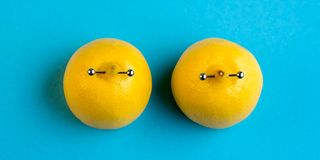
Lemons in the shape of a woman's breast with nipple piercing on.
Body art has gained popularity in Kenya, and younger women have not spared the breast.
Breast piercings and tattoos may have previously been considered unconventional, but they are now a powerful statement of self-expression and beauty. From tiny nipple rings to elaborate designs of chains and gemstones, women have gotten bolder.
Ayub Mwaluma, who owns a tattoo parlour, Mwaluma Arts and Tattoos, in Nairobi, says there is an uptake of breast tattoos among women, and the allure often lies in “having a traditionally private area transformed into a canvas for intricate designs and intimate messages.”
Similarly, nipple piercings are seen as a form of empowerment or rebellion against conventional beauty standards.
“More women are coming in for both nipple piercings and breast tattoos. This trend is about more than aesthetics; it’s about reclaiming personal space and celebrating individuality. The women are in their 20s to 30s,” he told Nation Lifestyle.
So how is the nipple piercing done?
Also Read: Men who want to breastfeed
Nipple piercings, Ayub says, while generally straightforward, require thoroughness.
“You first mark and measure the spot for the needle insertion, allowing the client to view and approve if that is the right spot. Then, using a hollow needle, I make a hole through the nipple. The needle is designed to reduce discomfort. It is a fast process. Next comes the insertion of jewellery: once the needle has created the hole, the selected jewellery—usually a small, curved barbell or hoop—is threaded into the new opening. It’s important to choose hypoallergenic jewellery to avoid allergic reactions,” he said.
When doing the nipple piercing which costs Sh15,000, Ayub says they apply an anaesthetic spray to the breast area.
“After spraying, we let it sit for 30 minutes before proceeding with the piercing. We provide clients with nipple covers or advise them to come with an extra clean cloth or, preferably, a new cloth, as the area is sensitive,” he said.
Clogged milk ducts
A majority of the women doing body art are in their child-bearing age, will the nipple piercings and breast tattoos affect breastfeeding when they get children?
Esther Kimani, an infant feeding specialist and lactation consultant with the Kenya Association for Breastfeeding says that nipple piercings can cause scar tissue, which block the milk ducts, preventing milk from flowing properly.
Also Read: “Breast milk donors came to our rescue”
“The scar tissue interferes with milk flow. This can lead to issues like blocked ducts or even the inability to breastfeed. If you’re planning to pierce or do breast augmentation, consider future breastfeeding plans and consult your doctor to avoid complications,” she said.
Body modifications like piercings or breast surgeries alter the breast’s physiology, Ms Kimani says, and lead to complications such as engorgement, mastitis, or clogged ducts.
“Scar tissue can also cause pain and discomfort,” she said.
No milk
Ms Kimani recounts a case where a mother with a nipple piercing was unable to breastfeed due to significant scar tissue blocking the milk ducts.
“The scar tissue was so extensive that it obstructed the ducts, which not only hindered milk flow but ultimately forced a stop to her milk production,” she says.
Infections
In contrast to breast tattoos, which are applied more superficially to the skin, Ms Kimani notes that they pose less risk to breastfeeding.
“Tattooing generally affects only the outer layer of the breast and does not interfere with the internal milk ducts. Many mothers with breast tattoos have successfully breastfed their babies,” she said.
Proper hygiene and after-care of the piercing site is also another challenge. Infections may occur.
“If you’re planning to breastfeed, weigh the risks, choose a reputable and hygienic piercing or tattoo parlour to prevent infections and complications,” Ms Kimani said, “if you have a piercing and are breastfeeding, remove the jewellery during nursing sessions and ensure the area is clean. Breastfeeding with piercings can make it difficult for the infant to latch on correctly, and increase the risk of choking if the jewellery becomes loose and dislodges.”







